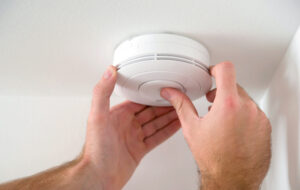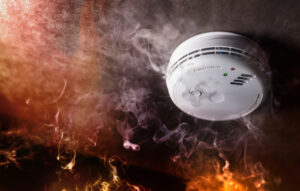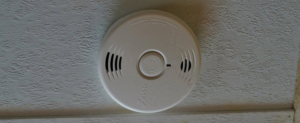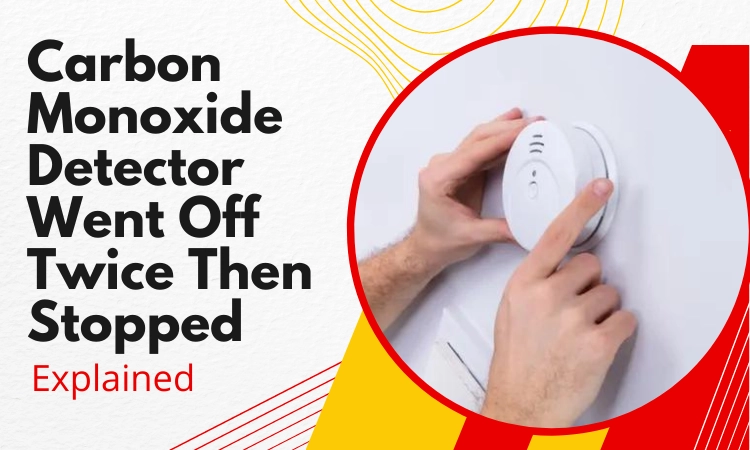The Carbon Monoxide Detector went off twice and then stopped because there is a rise in CO in your room or building. If this is the case then leave the building immediately and call the fire service department or 911. Look for your family members and friends and ensure that everyone has got out. Don’t enter the building until the situation is under control.
It is better to keep the room ventilated or check the expiration date of the CO alarm. To get a better idea of what to do next or how to avoid CO poisoning, keep reading this article.
Why Would CO Detector Ring Twice & Stop?
A CO Detector rings twice and then stops if there is a sudden rise in Carbon Monoxide. Leave the room immediately and open the windows to let air in and ensure proper ventilation.
If the CO detector beeps twice every 30 seconds then it’s a reminder to replace it. Because it may have reached its lifetime. CO detectors last about 5-7 years. It won’t work properly after it reaches the expiration time. Check the expiration date by looking at the label on the detector.
It could also be an internal malfunction that is causing the beeping sound. Change the battery to see if the problem goes away. Also, read the user’s manual to see if there are any instructions on it.
CO detectors with clogged sensors often make false alarms. Make sure to clean the CO detectors once in a while. It’s a part of regular maintenance.
If nothing works then it may have to be replaced. But consult with a technician before discarding it as an expert might be able to solve it.
What To Do If CO Alarm Goes Off?
If the CO alarm goes off leave the room or the building immediately. Carbon monoxide is a poisonous gas that can kill you. Normally, CO detectors beep 4 to 5 times to warn about the presence of this gas. Depending on the model the signals can be different but if it beeps more than once, leave the vicinity.

The following are the next steps to take if your CO detector alarm is ringing.
Step 1: Move Outdoors
If the carbon monoxide detector rings leave the room and go outside. While doing so make sure to open up all the windows to let air in.
But if you feel nauseous or short on breath, then evacuate first. Don’t waste time opening the windows.
Step 2: Call The Local Emergency Service
Call the local fire department or 911. Make sure that all your family members have evacuated from the house.
Check to see if the others have also left the building. If someone is missing, it is better not to get back in to look for them. Mention it to the emergency services about them. They will find them.
Always keep an evacuation plan ready beforehand. It’ll come in handy in fire emergencies like when the fire alarm makes a whoop-whoop sound.
Step 3: Inspect For CO Leaks
After the emergency passes, you’d have to inspect for the carbon monoxide leak. A specialist must conduct the inspection. to pinpoint the cause of the leakage.
Carbon monoxide is generated from several sources in your home. For example-
- Fireplaces
- Chimneys or furnaces
- Cigarette smoke
- Stoves for wood-burning
- Generators
- Boilers
- Central heating system
- Gas rangers
- Ventilation systems
Although these sources are harmless, CO leakage happens when they are damaged or installed improperly. If you don’t use them properly then there can be carbon monoxide leakage.
Keep an eye out during winter. Since this is the time when you might keep the windows closed and use stoves and chimneys. Watch out if the chimney is blocked by snow or anything else. Because that means the smoke will enter the home instead of getting released out.
Step 4: Schedule CO Test Occasionally
Even though CO detector alarms are to be taken seriously, there are cases of false alarms. If the detector is not checked for a long time, false alarms can happen.
That’s why they need regular inspections. You can conduct one with the fire alarm inspection. The cost of a fire alarm inspection isn’t much. The fire alarm inspection might include the CO detector inspection as well.
If the CO detector is plugged into an outlet, it needs to be checked once a month. Those that are battery-operated, need battery replacement once a year.
A scheduled inspection will tell you all the changes and fixes the system may need.
Symptoms Of Carbon Monoxide Exposure
When left in the carbon monoxide for long, some symptoms will appear. Such as-
- Headache
- Fatigue
- Drowsiness
- Shortness of breath
- Impaired judgment
- Low blood pressure
- Confusion
- Chest pain
- Rapid heartbeat
- Nausea and vomiting
- Feeling weak
- Muscle pain
- Blurred vision
In case of severe CO poisoning, people can lose consciousness along with muscular coordination. It can even lead to death.

What To Do If Someone Has Carbon Monoxide Poisoning?
If you suspect someone to have CO poisoning, send them to doctors immediately. But instant medical attention is needed. Here’s what you can do-
- Move the person into the fresh air and call 911. If the person is unconscious, first check for any injuries before transporting him.
- If the individual is not reacting or is not breathing properly, you may have to perform CPR.
- Continue giving CPR until the person starts to breathe again.
- Hand him over to the medical staff.
How To Reduce Carbon Monoxide In Home?

Preventing CO formation in your home is the best way to avoid CO exposure. Here’s how you can prevent it.
Keep Fireplaces & Furnaces Clean:
Make sure the fireplace chimney or the furnace in your home isn’t clogged. If the fume gets blocked on the exit path, it enters the house instead.
Especially for wood fireplaces, the chimney must not be blocked by any object. For gas fireplaces, you don’t need to worry about the chimney. Since a chimney for a gas fireplace is not needed.
Before starting a fire, maintain the fireplace flue damper. It should be kept open until there are no flames and the ashes turn cold.
Don’t Let Your Car Idling In Closed Garage:
Never leave your vehicle idling in the garage. It raises the CO level in the air. Although garages are usually open, CO can still seep into your home through the garage.
Service The Heating Appliances:
Damaged or old heating appliances form carbon monoxide in the home. So, make sure to service them on occasion. Keep the house ventilated properly.
Also, ensure that heating appliances are used properly.
Avoid installing Generator Indoors:
Generators also produce carbon monoxide. So, they should be equipped far away from your house. If you need one, make sure to install it around 20 feet away from windows.
Frequently Asked Questions (FAQs):
What Level of Carbon Monoxide is Dangerous?
70 ppm of carbon monoxide or a higher amount of CO is dangerous. Above this level, people experience headaches, fatigue, and nausea. At 150-200 ppm concentrations, people lose consciousness and can even die. The permissible amount of CO in the air is about 50 ppm at maximum.
What Other Gases Can Set Off a Carbon Monoxide Detector?
Low-quality CO detectors can be set off by other gases like hydrogen cyanide, hydrogen sulfide, and nitrogen dioxide. It can also be set off by a large amount of fumes from burning petrol. Or the vapor of ethyl, isopropyl alcohol, acetylene, methyl, dimethyl sulfide, etc.
Can Humidity Set Off Carbon Monoxide Detector?
Yes, humidity can trigger the carbon monoxide detector. The detector collects the humidity around the sensor and this leads to a false alarm. High moisture content in the air can also cause corrosion to the sensor. Your home’s humidity level should be anywhere from 30 and 50%.
Conclusion
Now you know why your carbon monoxide detector went off twice and then stopped. We hope you found the information useful.
Consult a professional before making any changes to your CO detector. Also, don’t forget about the warranty if you need a replacement.
Stay safe!

